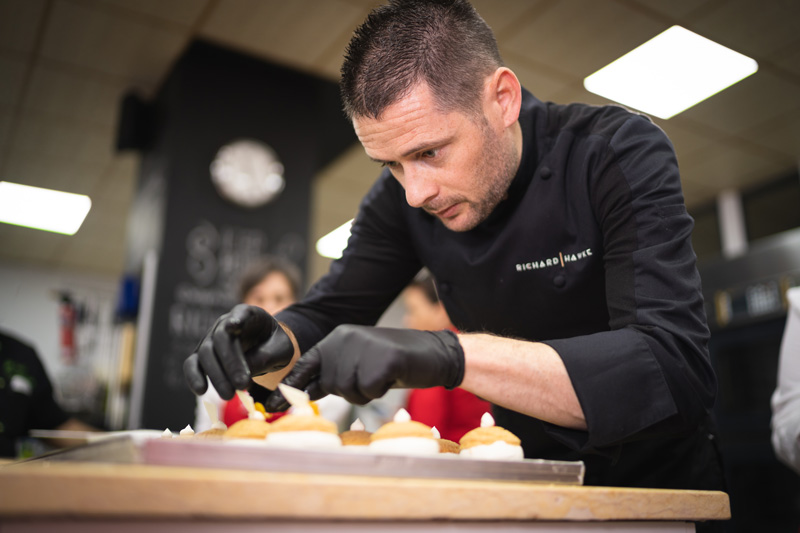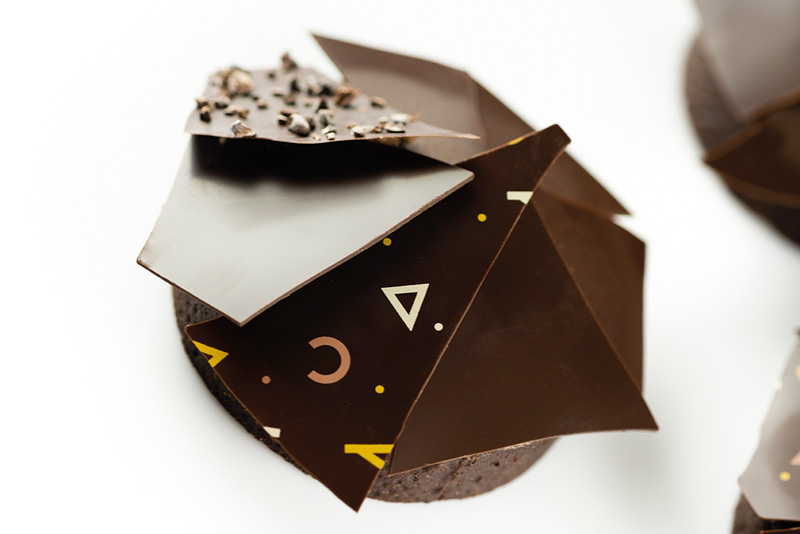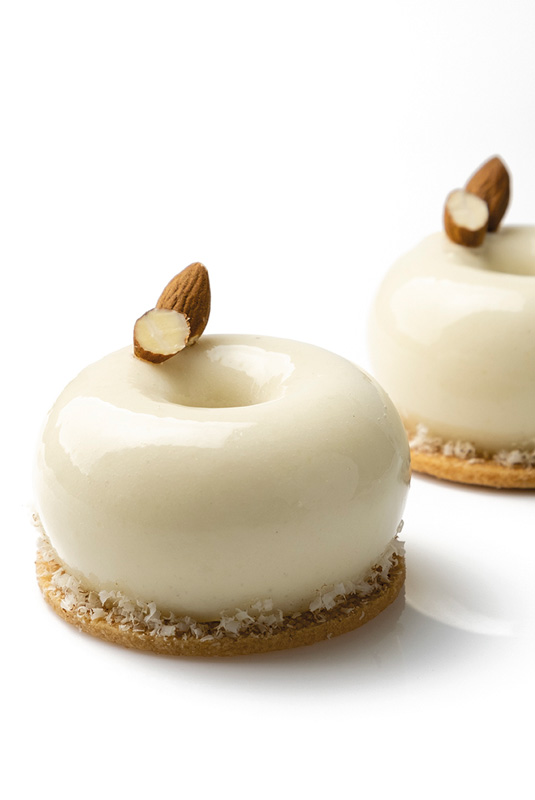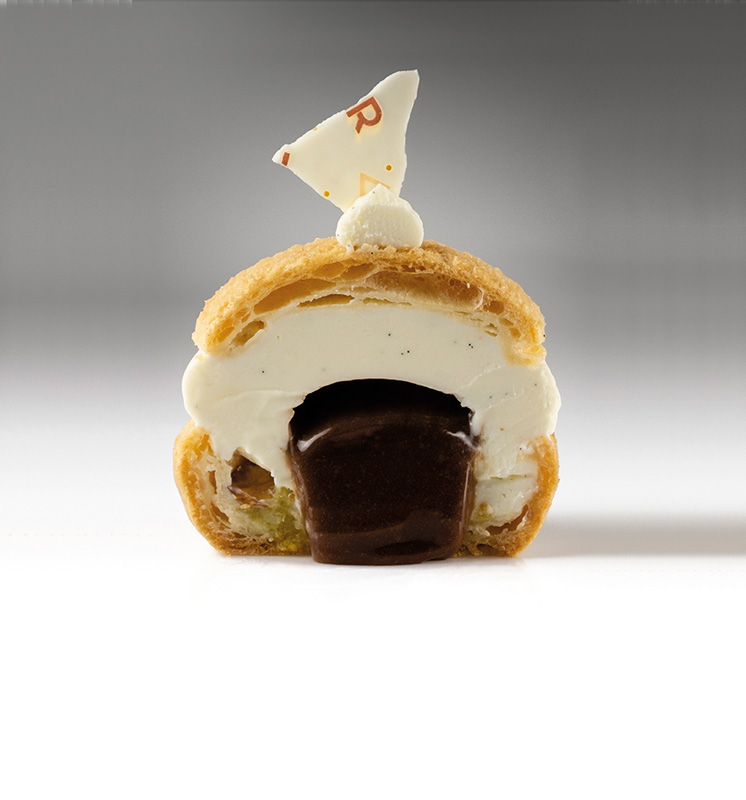Categories Pastry Chef Articles
Richard Hawke: ‘We don’t get taught how to really understand the ingredients in our recipes’

His time at the Ecole National Superieur de la Pâtissèrie (ENSP) as an international teacher opened the doors of teaching and pedagogy in front of him. A dream that also gave Richard Hawke the opportunity to enrich himself from working alongside great chefs. But it was not be until his job as head pastry chef in the development of a gluten-free offer in Rose Léon Patisserie (Casablanca, Morocco) that his patisserie took a new direction. That is when he assumed a clear objective in his role as international pastry consultant around the world through advice and demonstrations. Improving the way ingredients are used and learning to create a recipe from scratch are prerequisites to help other pastry chefs. It is not only about adapting one’s creations to gluten-free or allergy-proof patisserie, but also, as we could see in so good #21, developing lighter products. Recipes that, at the same time, do not leave a good balance of flavors and textures aside.

What is your current role in Natacha Pacal Patisserie in Bratislava?
I am helping with the opening of the first points of sale as well as creating and implementing the pastry range. We have started with only one ‘salon de thé’ with a selection of 8 petit gateaux. My role is to train the staff and ensure product quality as well as creating new products. I help with the choice of machines that are in the lab. We are going to be building a 500 m² lab with facilities for ice cream, pastry, chocolate and confectionary. As well we will be creating a specific lab which will be gluten-free, so that we can offer both classic pastries as well as gluten-free ones. I only work there on a part-time basis of which my spare time I travel the world giving pastry masterclasses.
There are lot of food trends in pastry, the main thing that I can think of is Instagram and the fact that we are more and more focused on a ‘perfect’ looking product and less on the flavour.
How are the new food trends changing the world of pastry?
The big trend for pastry is that we are getting more and more people who are allergic to various things.
For me the biggest trends are gluten-free, lactose-free, there is also a new wave of vegan. After all of the allergenic pastry, I think that there are two things the modern consumer is aware of: reduced fat and sugar. In France titanium dioxide is illegal from January 2019 and with it gold and silver luster dust due to containing E171 as well. I think that this trend will quickly spread around the world. I think that rather than using artificial food colourings we will move to the natural ones.
Are the pastry chefs prepared to adapt their offer to the new demands from the consumers?
In my opinion there are far too many chefs who don’t know how to handle all of these demands from their clients. They either don’t have the time or the knowledge to combat these problems. In my classes I explain how to adapt traditional pastry (with wheat flour) to gluten-free pastry, but the main problem for most professionals is that there aren’t any good books on the subject that help simplify the process and explain well.
What are the main steps in your personal research to achieve a lighter product and to adapt your pastry to the different aspects of allergenic pastry?
After my experience of teaching in ENSP, I had a long list of classic recipes that I wanted to change for various reasons. I didn’t like certain textures or I just wanted to reduce the sugar or fat in recipes. It is a very hard process because when we learn pastry we don’t get taught how to really understand the ingredients in our recipes. I have colleagues who look for recipes as opposed to really understanding the ingredients in order to develop recipes for their needs.
Too many chefs just reproduce the recipes that their chefs taught them without really understanding the role of all of the ingredients.
Give us an example of your personal experience in this field and explain to us two of your main ingredients.
When taking the fat out of my products I created problems that had never happened before for me in pastry. When I was taking the fat out of mousses I took so much fat out that once set in the refrigerator I had a nice texture, but once frozen and defrosted my mousses started weeping with the increased water content in my products.
With all of my allergenic pastry I am looking to create textures and similar recipes that I used to make, but just in a lighter (fat and sugar) way. My ganache aerienne is a good example as well. I started with what everyone knows as a whipped ganache, but I reduced the fat in the recipe. As the recipe has been altered I no longer wanted to call it a whipped ganache as people associate that already with something else. I wanted to give another name because it is a new product.
I use brown rice flour for its lower glycemic index as opposed to whole rice four. Rice flour gives a nice texture when used in shortbreads. However when used 100% to replace wheat flour in a sponge it can give an impression that someone put sand into the sponge. On the other hand, the coconut sugar has a low glycemic index (35), and helps me reduce the glycemic index in my pastries. I am careful where I use it as it is hydroscopic and therefore not interesting in shortbreads or crunches. If used in high concentrations it also give a certain flavour to preparations. I try and find a balance with my ingredients to enable the right texture and flavour.





